Hazardous Waste Land Disposal: Assessing Environmental Impact Risks
VerifiedAdded on 2023/06/05
|17
|5051
|258
Report
AI Summary
This report discusses the environmental consequences of hazardous waste land disposal, highlighting the various types of pollution caused by such practices, including air, water, and land pollution. It identifies hazardous wastes such as solvents, radioactive materials, batteries, and pesticides, and explores alternative waste disposal strategies like onsite containment, online destruction (pyrolysis), incineration, and recycling. The report further examines policies related to hazardous waste land disposal in Australia and internationally, emphasizing the importance of proper waste management to mitigate environmental damage and protect human health. Desklib offers a platform to access this and other related study resources.
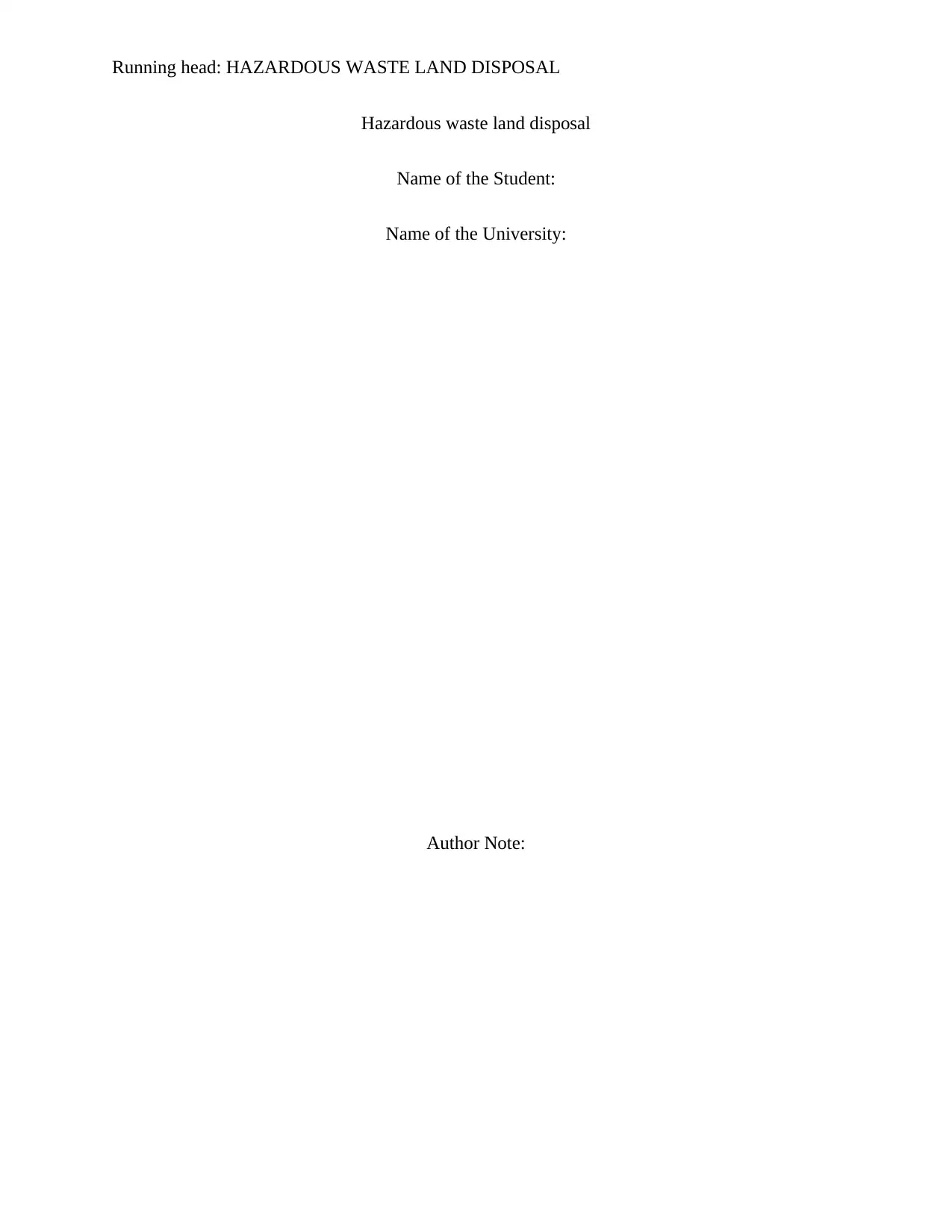
Running head: HAZARDOUS WASTE LAND DISPOSAL
Hazardous waste land disposal
Name of the Student:
Name of the University:
Author Note:
Hazardous waste land disposal
Name of the Student:
Name of the University:
Author Note:
Paraphrase This Document
Need a fresh take? Get an instant paraphrase of this document with our AI Paraphraser
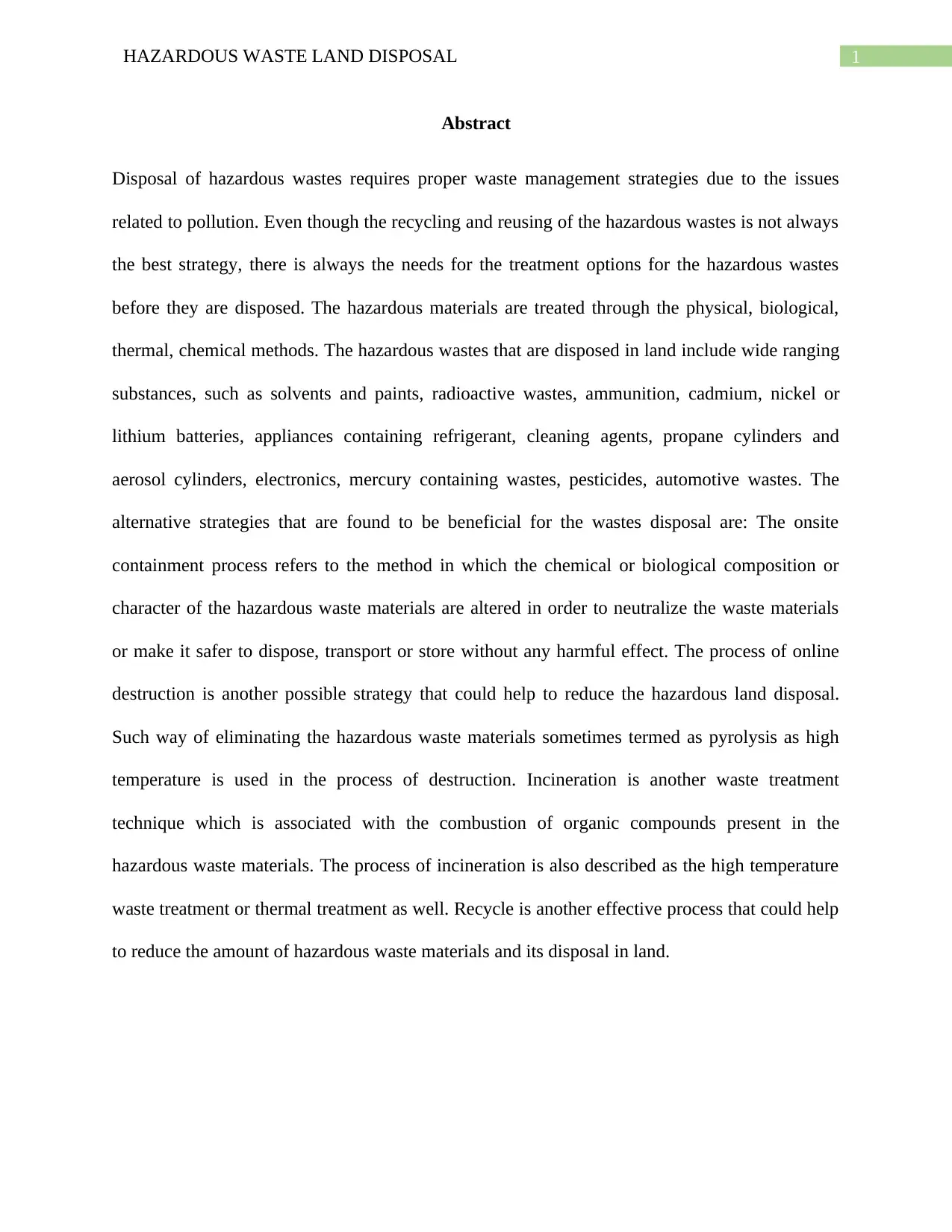
1HAZARDOUS WASTE LAND DISPOSAL
Abstract
Disposal of hazardous wastes requires proper waste management strategies due to the issues
related to pollution. Even though the recycling and reusing of the hazardous wastes is not always
the best strategy, there is always the needs for the treatment options for the hazardous wastes
before they are disposed. The hazardous materials are treated through the physical, biological,
thermal, chemical methods. The hazardous wastes that are disposed in land include wide ranging
substances, such as solvents and paints, radioactive wastes, ammunition, cadmium, nickel or
lithium batteries, appliances containing refrigerant, cleaning agents, propane cylinders and
aerosol cylinders, electronics, mercury containing wastes, pesticides, automotive wastes. The
alternative strategies that are found to be beneficial for the wastes disposal are: The onsite
containment process refers to the method in which the chemical or biological composition or
character of the hazardous waste materials are altered in order to neutralize the waste materials
or make it safer to dispose, transport or store without any harmful effect. The process of online
destruction is another possible strategy that could help to reduce the hazardous land disposal.
Such way of eliminating the hazardous waste materials sometimes termed as pyrolysis as high
temperature is used in the process of destruction. Incineration is another waste treatment
technique which is associated with the combustion of organic compounds present in the
hazardous waste materials. The process of incineration is also described as the high temperature
waste treatment or thermal treatment as well. Recycle is another effective process that could help
to reduce the amount of hazardous waste materials and its disposal in land.
Abstract
Disposal of hazardous wastes requires proper waste management strategies due to the issues
related to pollution. Even though the recycling and reusing of the hazardous wastes is not always
the best strategy, there is always the needs for the treatment options for the hazardous wastes
before they are disposed. The hazardous materials are treated through the physical, biological,
thermal, chemical methods. The hazardous wastes that are disposed in land include wide ranging
substances, such as solvents and paints, radioactive wastes, ammunition, cadmium, nickel or
lithium batteries, appliances containing refrigerant, cleaning agents, propane cylinders and
aerosol cylinders, electronics, mercury containing wastes, pesticides, automotive wastes. The
alternative strategies that are found to be beneficial for the wastes disposal are: The onsite
containment process refers to the method in which the chemical or biological composition or
character of the hazardous waste materials are altered in order to neutralize the waste materials
or make it safer to dispose, transport or store without any harmful effect. The process of online
destruction is another possible strategy that could help to reduce the hazardous land disposal.
Such way of eliminating the hazardous waste materials sometimes termed as pyrolysis as high
temperature is used in the process of destruction. Incineration is another waste treatment
technique which is associated with the combustion of organic compounds present in the
hazardous waste materials. The process of incineration is also described as the high temperature
waste treatment or thermal treatment as well. Recycle is another effective process that could help
to reduce the amount of hazardous waste materials and its disposal in land.
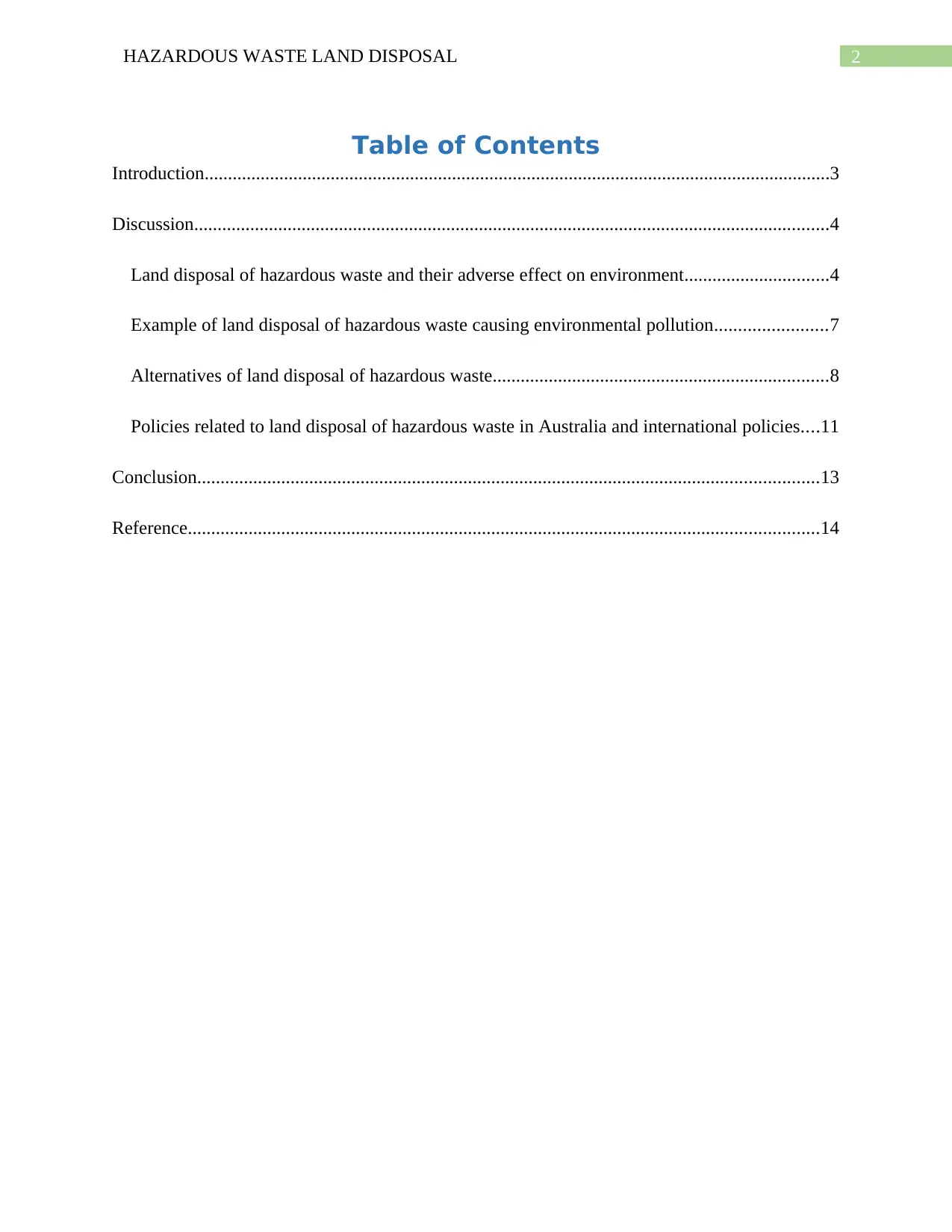
2HAZARDOUS WASTE LAND DISPOSAL
Table of Contents
Introduction......................................................................................................................................3
Discussion........................................................................................................................................4
Land disposal of hazardous waste and their adverse effect on environment...............................4
Example of land disposal of hazardous waste causing environmental pollution........................7
Alternatives of land disposal of hazardous waste........................................................................8
Policies related to land disposal of hazardous waste in Australia and international policies....11
Conclusion.....................................................................................................................................13
Reference.......................................................................................................................................14
Table of Contents
Introduction......................................................................................................................................3
Discussion........................................................................................................................................4
Land disposal of hazardous waste and their adverse effect on environment...............................4
Example of land disposal of hazardous waste causing environmental pollution........................7
Alternatives of land disposal of hazardous waste........................................................................8
Policies related to land disposal of hazardous waste in Australia and international policies....11
Conclusion.....................................................................................................................................13
Reference.......................................................................................................................................14
⊘ This is a preview!⊘
Do you want full access?
Subscribe today to unlock all pages.

Trusted by 1+ million students worldwide
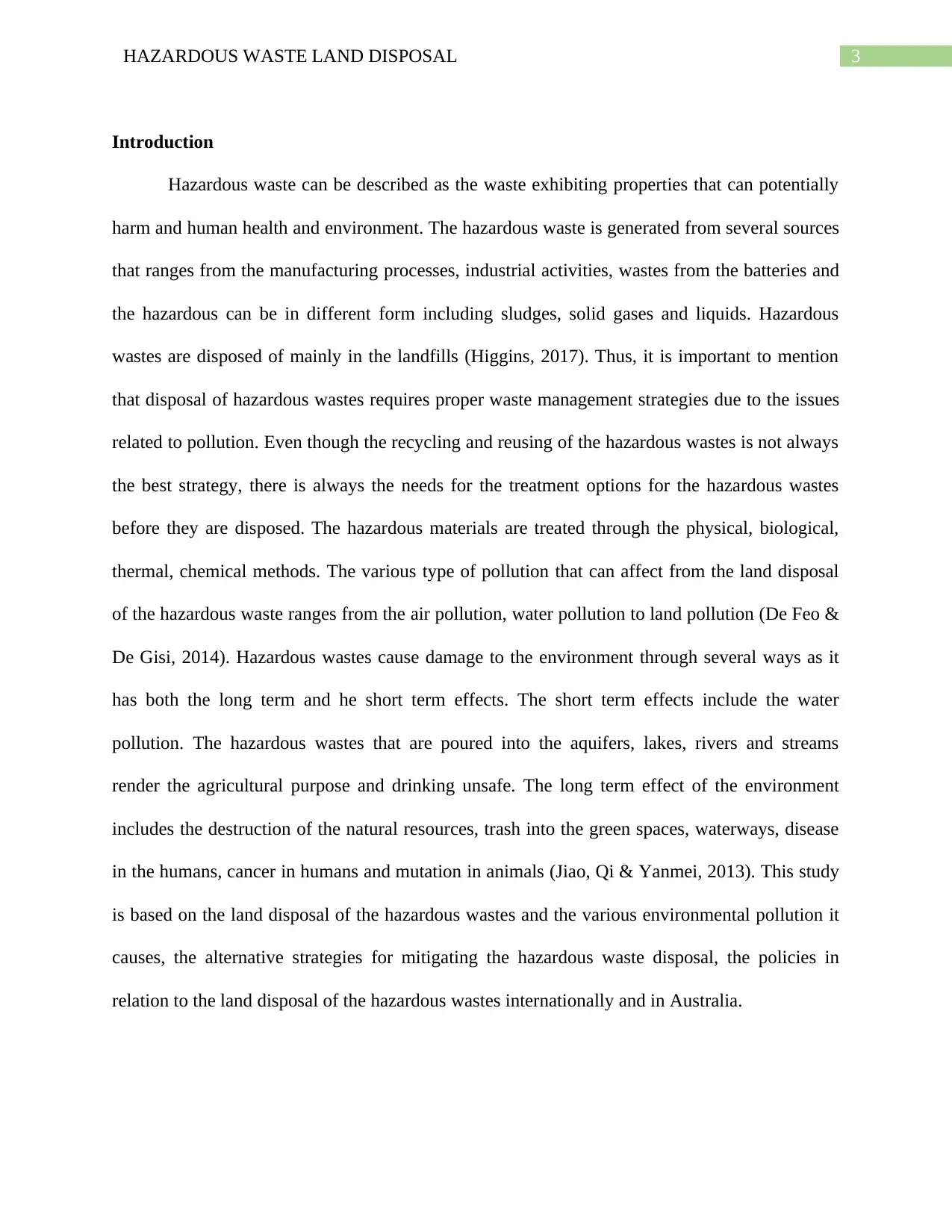
3HAZARDOUS WASTE LAND DISPOSAL
Introduction
Hazardous waste can be described as the waste exhibiting properties that can potentially
harm and human health and environment. The hazardous waste is generated from several sources
that ranges from the manufacturing processes, industrial activities, wastes from the batteries and
the hazardous can be in different form including sludges, solid gases and liquids. Hazardous
wastes are disposed of mainly in the landfills (Higgins, 2017). Thus, it is important to mention
that disposal of hazardous wastes requires proper waste management strategies due to the issues
related to pollution. Even though the recycling and reusing of the hazardous wastes is not always
the best strategy, there is always the needs for the treatment options for the hazardous wastes
before they are disposed. The hazardous materials are treated through the physical, biological,
thermal, chemical methods. The various type of pollution that can affect from the land disposal
of the hazardous waste ranges from the air pollution, water pollution to land pollution (De Feo &
De Gisi, 2014). Hazardous wastes cause damage to the environment through several ways as it
has both the long term and he short term effects. The short term effects include the water
pollution. The hazardous wastes that are poured into the aquifers, lakes, rivers and streams
render the agricultural purpose and drinking unsafe. The long term effect of the environment
includes the destruction of the natural resources, trash into the green spaces, waterways, disease
in the humans, cancer in humans and mutation in animals (Jiao, Qi & Yanmei, 2013). This study
is based on the land disposal of the hazardous wastes and the various environmental pollution it
causes, the alternative strategies for mitigating the hazardous waste disposal, the policies in
relation to the land disposal of the hazardous wastes internationally and in Australia.
Introduction
Hazardous waste can be described as the waste exhibiting properties that can potentially
harm and human health and environment. The hazardous waste is generated from several sources
that ranges from the manufacturing processes, industrial activities, wastes from the batteries and
the hazardous can be in different form including sludges, solid gases and liquids. Hazardous
wastes are disposed of mainly in the landfills (Higgins, 2017). Thus, it is important to mention
that disposal of hazardous wastes requires proper waste management strategies due to the issues
related to pollution. Even though the recycling and reusing of the hazardous wastes is not always
the best strategy, there is always the needs for the treatment options for the hazardous wastes
before they are disposed. The hazardous materials are treated through the physical, biological,
thermal, chemical methods. The various type of pollution that can affect from the land disposal
of the hazardous waste ranges from the air pollution, water pollution to land pollution (De Feo &
De Gisi, 2014). Hazardous wastes cause damage to the environment through several ways as it
has both the long term and he short term effects. The short term effects include the water
pollution. The hazardous wastes that are poured into the aquifers, lakes, rivers and streams
render the agricultural purpose and drinking unsafe. The long term effect of the environment
includes the destruction of the natural resources, trash into the green spaces, waterways, disease
in the humans, cancer in humans and mutation in animals (Jiao, Qi & Yanmei, 2013). This study
is based on the land disposal of the hazardous wastes and the various environmental pollution it
causes, the alternative strategies for mitigating the hazardous waste disposal, the policies in
relation to the land disposal of the hazardous wastes internationally and in Australia.
Paraphrase This Document
Need a fresh take? Get an instant paraphrase of this document with our AI Paraphraser
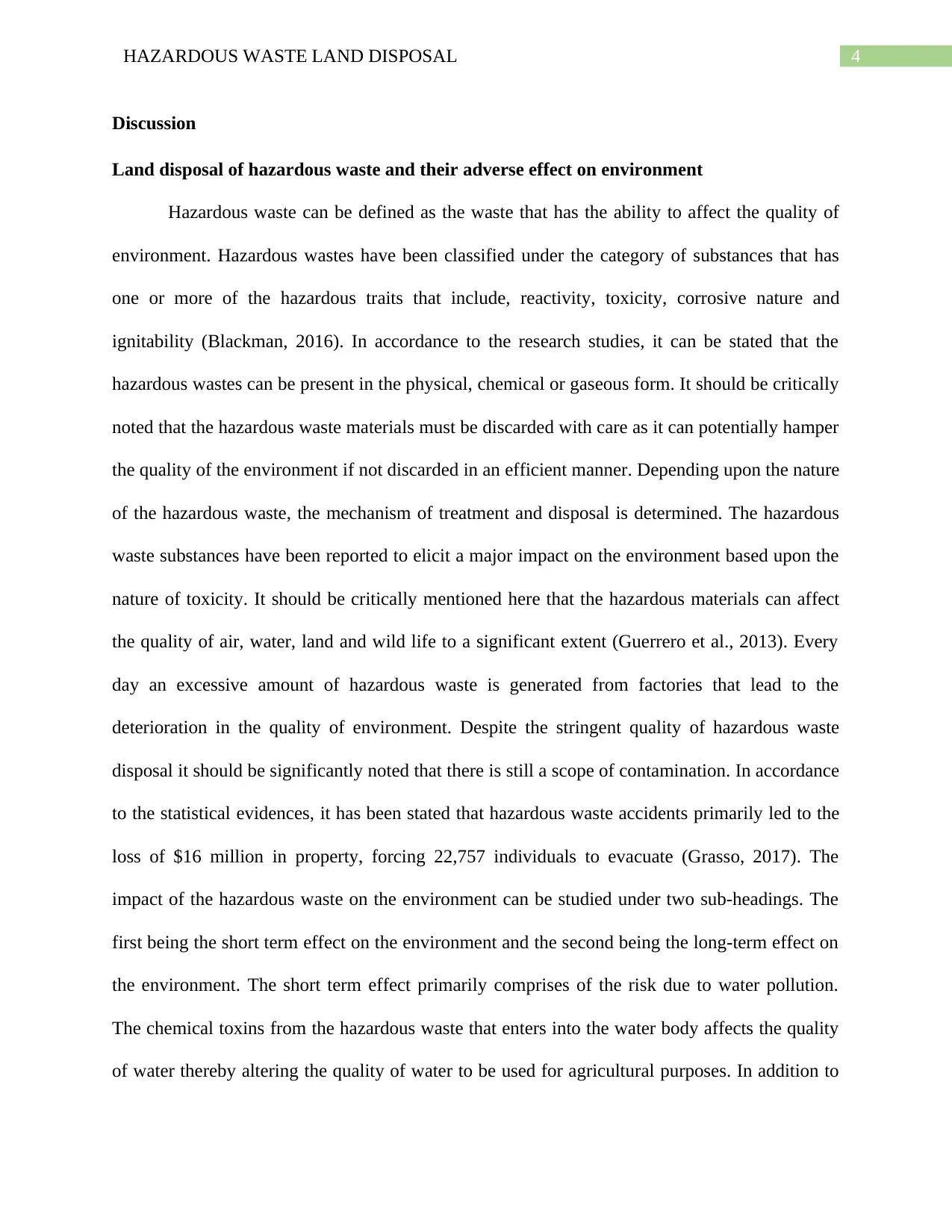
4HAZARDOUS WASTE LAND DISPOSAL
Discussion
Land disposal of hazardous waste and their adverse effect on environment
Hazardous waste can be defined as the waste that has the ability to affect the quality of
environment. Hazardous wastes have been classified under the category of substances that has
one or more of the hazardous traits that include, reactivity, toxicity, corrosive nature and
ignitability (Blackman, 2016). In accordance to the research studies, it can be stated that the
hazardous wastes can be present in the physical, chemical or gaseous form. It should be critically
noted that the hazardous waste materials must be discarded with care as it can potentially hamper
the quality of the environment if not discarded in an efficient manner. Depending upon the nature
of the hazardous waste, the mechanism of treatment and disposal is determined. The hazardous
waste substances have been reported to elicit a major impact on the environment based upon the
nature of toxicity. It should be critically mentioned here that the hazardous materials can affect
the quality of air, water, land and wild life to a significant extent (Guerrero et al., 2013). Every
day an excessive amount of hazardous waste is generated from factories that lead to the
deterioration in the quality of environment. Despite the stringent quality of hazardous waste
disposal it should be significantly noted that there is still a scope of contamination. In accordance
to the statistical evidences, it has been stated that hazardous waste accidents primarily led to the
loss of $16 million in property, forcing 22,757 individuals to evacuate (Grasso, 2017). The
impact of the hazardous waste on the environment can be studied under two sub-headings. The
first being the short term effect on the environment and the second being the long-term effect on
the environment. The short term effect primarily comprises of the risk due to water pollution.
The chemical toxins from the hazardous waste that enters into the water body affects the quality
of water thereby altering the quality of water to be used for agricultural purposes. In addition to
Discussion
Land disposal of hazardous waste and their adverse effect on environment
Hazardous waste can be defined as the waste that has the ability to affect the quality of
environment. Hazardous wastes have been classified under the category of substances that has
one or more of the hazardous traits that include, reactivity, toxicity, corrosive nature and
ignitability (Blackman, 2016). In accordance to the research studies, it can be stated that the
hazardous wastes can be present in the physical, chemical or gaseous form. It should be critically
noted that the hazardous waste materials must be discarded with care as it can potentially hamper
the quality of the environment if not discarded in an efficient manner. Depending upon the nature
of the hazardous waste, the mechanism of treatment and disposal is determined. The hazardous
waste substances have been reported to elicit a major impact on the environment based upon the
nature of toxicity. It should be critically mentioned here that the hazardous materials can affect
the quality of air, water, land and wild life to a significant extent (Guerrero et al., 2013). Every
day an excessive amount of hazardous waste is generated from factories that lead to the
deterioration in the quality of environment. Despite the stringent quality of hazardous waste
disposal it should be significantly noted that there is still a scope of contamination. In accordance
to the statistical evidences, it has been stated that hazardous waste accidents primarily led to the
loss of $16 million in property, forcing 22,757 individuals to evacuate (Grasso, 2017). The
impact of the hazardous waste on the environment can be studied under two sub-headings. The
first being the short term effect on the environment and the second being the long-term effect on
the environment. The short term effect primarily comprises of the risk due to water pollution.
The chemical toxins from the hazardous waste that enters into the water body affects the quality
of water thereby altering the quality of water to be used for agricultural purposes. In addition to
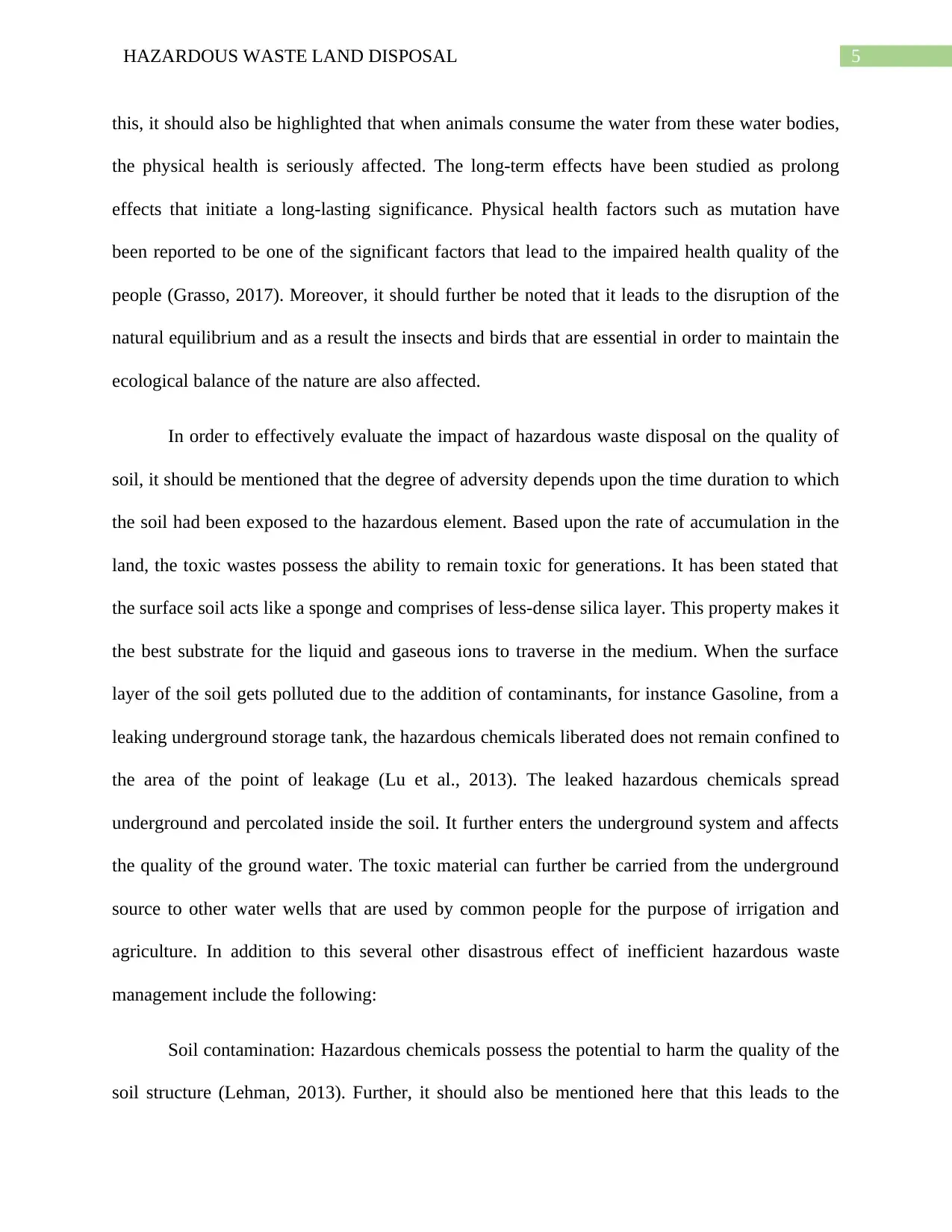
5HAZARDOUS WASTE LAND DISPOSAL
this, it should also be highlighted that when animals consume the water from these water bodies,
the physical health is seriously affected. The long-term effects have been studied as prolong
effects that initiate a long-lasting significance. Physical health factors such as mutation have
been reported to be one of the significant factors that lead to the impaired health quality of the
people (Grasso, 2017). Moreover, it should further be noted that it leads to the disruption of the
natural equilibrium and as a result the insects and birds that are essential in order to maintain the
ecological balance of the nature are also affected.
In order to effectively evaluate the impact of hazardous waste disposal on the quality of
soil, it should be mentioned that the degree of adversity depends upon the time duration to which
the soil had been exposed to the hazardous element. Based upon the rate of accumulation in the
land, the toxic wastes possess the ability to remain toxic for generations. It has been stated that
the surface soil acts like a sponge and comprises of less-dense silica layer. This property makes it
the best substrate for the liquid and gaseous ions to traverse in the medium. When the surface
layer of the soil gets polluted due to the addition of contaminants, for instance Gasoline, from a
leaking underground storage tank, the hazardous chemicals liberated does not remain confined to
the area of the point of leakage (Lu et al., 2013). The leaked hazardous chemicals spread
underground and percolated inside the soil. It further enters the underground system and affects
the quality of the ground water. The toxic material can further be carried from the underground
source to other water wells that are used by common people for the purpose of irrigation and
agriculture. In addition to this several other disastrous effect of inefficient hazardous waste
management include the following:
Soil contamination: Hazardous chemicals possess the potential to harm the quality of the
soil structure (Lehman, 2013). Further, it should also be mentioned here that this leads to the
this, it should also be highlighted that when animals consume the water from these water bodies,
the physical health is seriously affected. The long-term effects have been studied as prolong
effects that initiate a long-lasting significance. Physical health factors such as mutation have
been reported to be one of the significant factors that lead to the impaired health quality of the
people (Grasso, 2017). Moreover, it should further be noted that it leads to the disruption of the
natural equilibrium and as a result the insects and birds that are essential in order to maintain the
ecological balance of the nature are also affected.
In order to effectively evaluate the impact of hazardous waste disposal on the quality of
soil, it should be mentioned that the degree of adversity depends upon the time duration to which
the soil had been exposed to the hazardous element. Based upon the rate of accumulation in the
land, the toxic wastes possess the ability to remain toxic for generations. It has been stated that
the surface soil acts like a sponge and comprises of less-dense silica layer. This property makes it
the best substrate for the liquid and gaseous ions to traverse in the medium. When the surface
layer of the soil gets polluted due to the addition of contaminants, for instance Gasoline, from a
leaking underground storage tank, the hazardous chemicals liberated does not remain confined to
the area of the point of leakage (Lu et al., 2013). The leaked hazardous chemicals spread
underground and percolated inside the soil. It further enters the underground system and affects
the quality of the ground water. The toxic material can further be carried from the underground
source to other water wells that are used by common people for the purpose of irrigation and
agriculture. In addition to this several other disastrous effect of inefficient hazardous waste
management include the following:
Soil contamination: Hazardous chemicals possess the potential to harm the quality of the
soil structure (Lehman, 2013). Further, it should also be mentioned here that this leads to the
⊘ This is a preview!⊘
Do you want full access?
Subscribe today to unlock all pages.

Trusted by 1+ million students worldwide
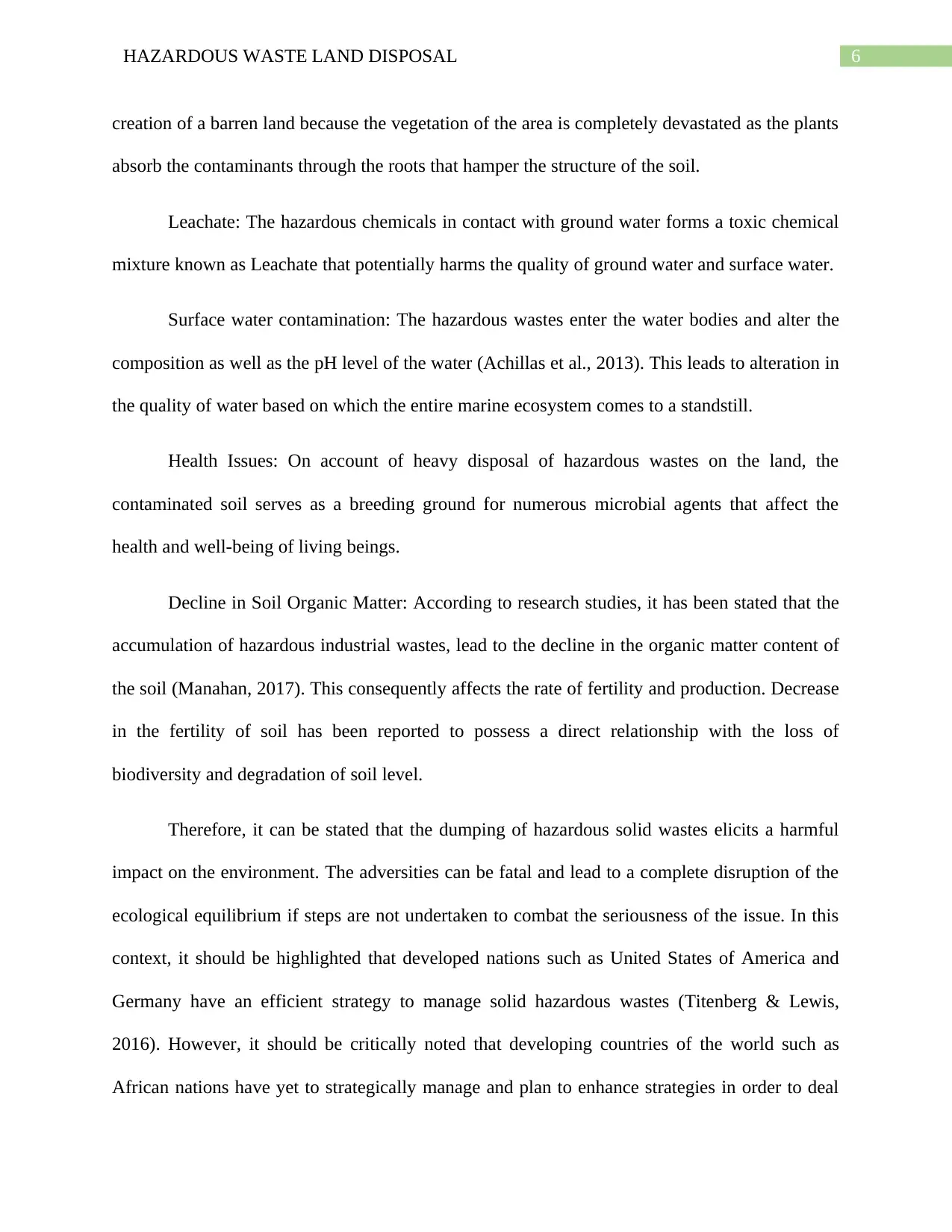
6HAZARDOUS WASTE LAND DISPOSAL
creation of a barren land because the vegetation of the area is completely devastated as the plants
absorb the contaminants through the roots that hamper the structure of the soil.
Leachate: The hazardous chemicals in contact with ground water forms a toxic chemical
mixture known as Leachate that potentially harms the quality of ground water and surface water.
Surface water contamination: The hazardous wastes enter the water bodies and alter the
composition as well as the pH level of the water (Achillas et al., 2013). This leads to alteration in
the quality of water based on which the entire marine ecosystem comes to a standstill.
Health Issues: On account of heavy disposal of hazardous wastes on the land, the
contaminated soil serves as a breeding ground for numerous microbial agents that affect the
health and well-being of living beings.
Decline in Soil Organic Matter: According to research studies, it has been stated that the
accumulation of hazardous industrial wastes, lead to the decline in the organic matter content of
the soil (Manahan, 2017). This consequently affects the rate of fertility and production. Decrease
in the fertility of soil has been reported to possess a direct relationship with the loss of
biodiversity and degradation of soil level.
Therefore, it can be stated that the dumping of hazardous solid wastes elicits a harmful
impact on the environment. The adversities can be fatal and lead to a complete disruption of the
ecological equilibrium if steps are not undertaken to combat the seriousness of the issue. In this
context, it should be highlighted that developed nations such as United States of America and
Germany have an efficient strategy to manage solid hazardous wastes (Titenberg & Lewis,
2016). However, it should be critically noted that developing countries of the world such as
African nations have yet to strategically manage and plan to enhance strategies in order to deal
creation of a barren land because the vegetation of the area is completely devastated as the plants
absorb the contaminants through the roots that hamper the structure of the soil.
Leachate: The hazardous chemicals in contact with ground water forms a toxic chemical
mixture known as Leachate that potentially harms the quality of ground water and surface water.
Surface water contamination: The hazardous wastes enter the water bodies and alter the
composition as well as the pH level of the water (Achillas et al., 2013). This leads to alteration in
the quality of water based on which the entire marine ecosystem comes to a standstill.
Health Issues: On account of heavy disposal of hazardous wastes on the land, the
contaminated soil serves as a breeding ground for numerous microbial agents that affect the
health and well-being of living beings.
Decline in Soil Organic Matter: According to research studies, it has been stated that the
accumulation of hazardous industrial wastes, lead to the decline in the organic matter content of
the soil (Manahan, 2017). This consequently affects the rate of fertility and production. Decrease
in the fertility of soil has been reported to possess a direct relationship with the loss of
biodiversity and degradation of soil level.
Therefore, it can be stated that the dumping of hazardous solid wastes elicits a harmful
impact on the environment. The adversities can be fatal and lead to a complete disruption of the
ecological equilibrium if steps are not undertaken to combat the seriousness of the issue. In this
context, it should be highlighted that developed nations such as United States of America and
Germany have an efficient strategy to manage solid hazardous wastes (Titenberg & Lewis,
2016). However, it should be critically noted that developing countries of the world such as
African nations have yet to strategically manage and plan to enhance strategies in order to deal
Paraphrase This Document
Need a fresh take? Get an instant paraphrase of this document with our AI Paraphraser
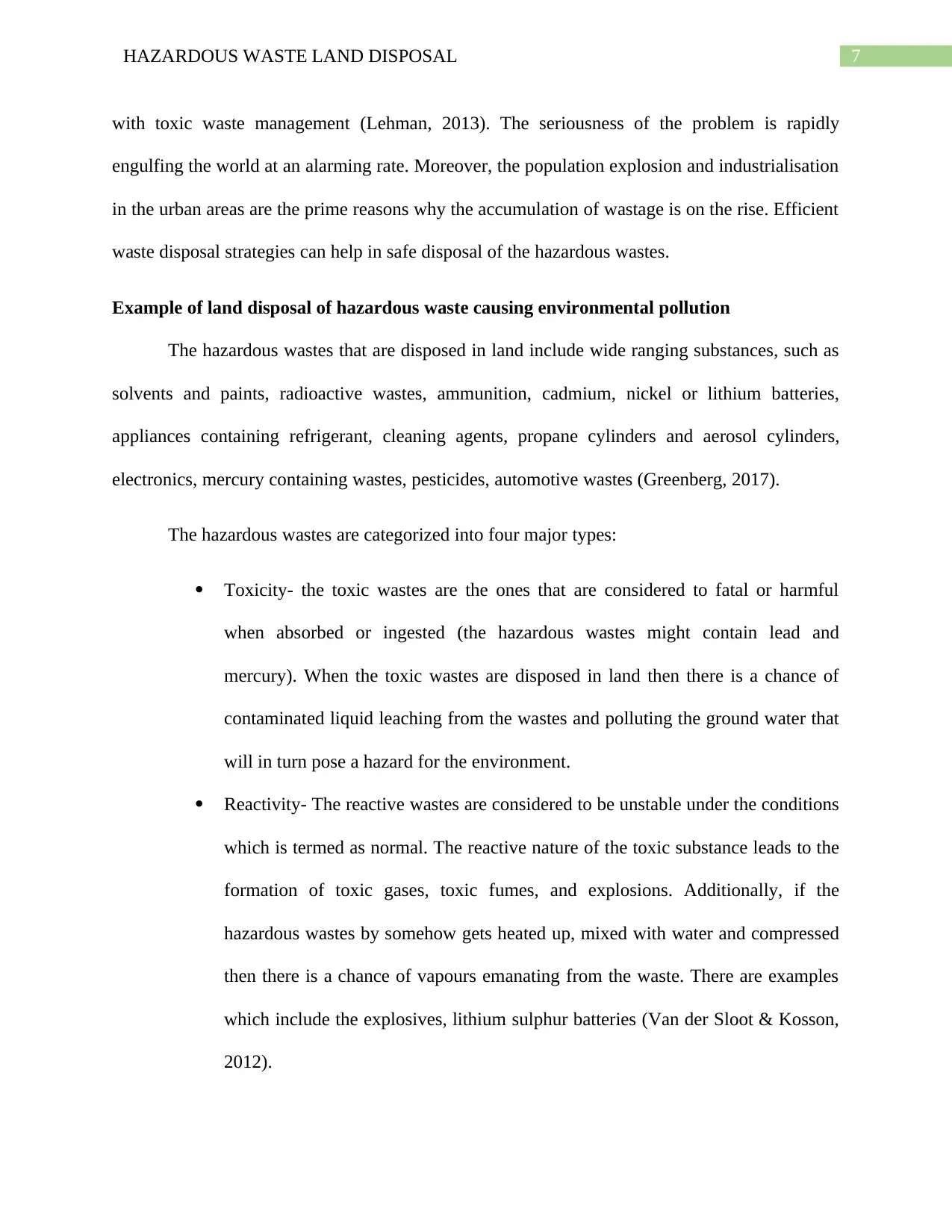
7HAZARDOUS WASTE LAND DISPOSAL
with toxic waste management (Lehman, 2013). The seriousness of the problem is rapidly
engulfing the world at an alarming rate. Moreover, the population explosion and industrialisation
in the urban areas are the prime reasons why the accumulation of wastage is on the rise. Efficient
waste disposal strategies can help in safe disposal of the hazardous wastes.
Example of land disposal of hazardous waste causing environmental pollution
The hazardous wastes that are disposed in land include wide ranging substances, such as
solvents and paints, radioactive wastes, ammunition, cadmium, nickel or lithium batteries,
appliances containing refrigerant, cleaning agents, propane cylinders and aerosol cylinders,
electronics, mercury containing wastes, pesticides, automotive wastes (Greenberg, 2017).
The hazardous wastes are categorized into four major types:
Toxicity- the toxic wastes are the ones that are considered to fatal or harmful
when absorbed or ingested (the hazardous wastes might contain lead and
mercury). When the toxic wastes are disposed in land then there is a chance of
contaminated liquid leaching from the wastes and polluting the ground water that
will in turn pose a hazard for the environment.
Reactivity- The reactive wastes are considered to be unstable under the conditions
which is termed as normal. The reactive nature of the toxic substance leads to the
formation of toxic gases, toxic fumes, and explosions. Additionally, if the
hazardous wastes by somehow gets heated up, mixed with water and compressed
then there is a chance of vapours emanating from the waste. There are examples
which include the explosives, lithium sulphur batteries (Van der Sloot & Kosson,
2012).
with toxic waste management (Lehman, 2013). The seriousness of the problem is rapidly
engulfing the world at an alarming rate. Moreover, the population explosion and industrialisation
in the urban areas are the prime reasons why the accumulation of wastage is on the rise. Efficient
waste disposal strategies can help in safe disposal of the hazardous wastes.
Example of land disposal of hazardous waste causing environmental pollution
The hazardous wastes that are disposed in land include wide ranging substances, such as
solvents and paints, radioactive wastes, ammunition, cadmium, nickel or lithium batteries,
appliances containing refrigerant, cleaning agents, propane cylinders and aerosol cylinders,
electronics, mercury containing wastes, pesticides, automotive wastes (Greenberg, 2017).
The hazardous wastes are categorized into four major types:
Toxicity- the toxic wastes are the ones that are considered to fatal or harmful
when absorbed or ingested (the hazardous wastes might contain lead and
mercury). When the toxic wastes are disposed in land then there is a chance of
contaminated liquid leaching from the wastes and polluting the ground water that
will in turn pose a hazard for the environment.
Reactivity- The reactive wastes are considered to be unstable under the conditions
which is termed as normal. The reactive nature of the toxic substance leads to the
formation of toxic gases, toxic fumes, and explosions. Additionally, if the
hazardous wastes by somehow gets heated up, mixed with water and compressed
then there is a chance of vapours emanating from the waste. There are examples
which include the explosives, lithium sulphur batteries (Van der Sloot & Kosson,
2012).
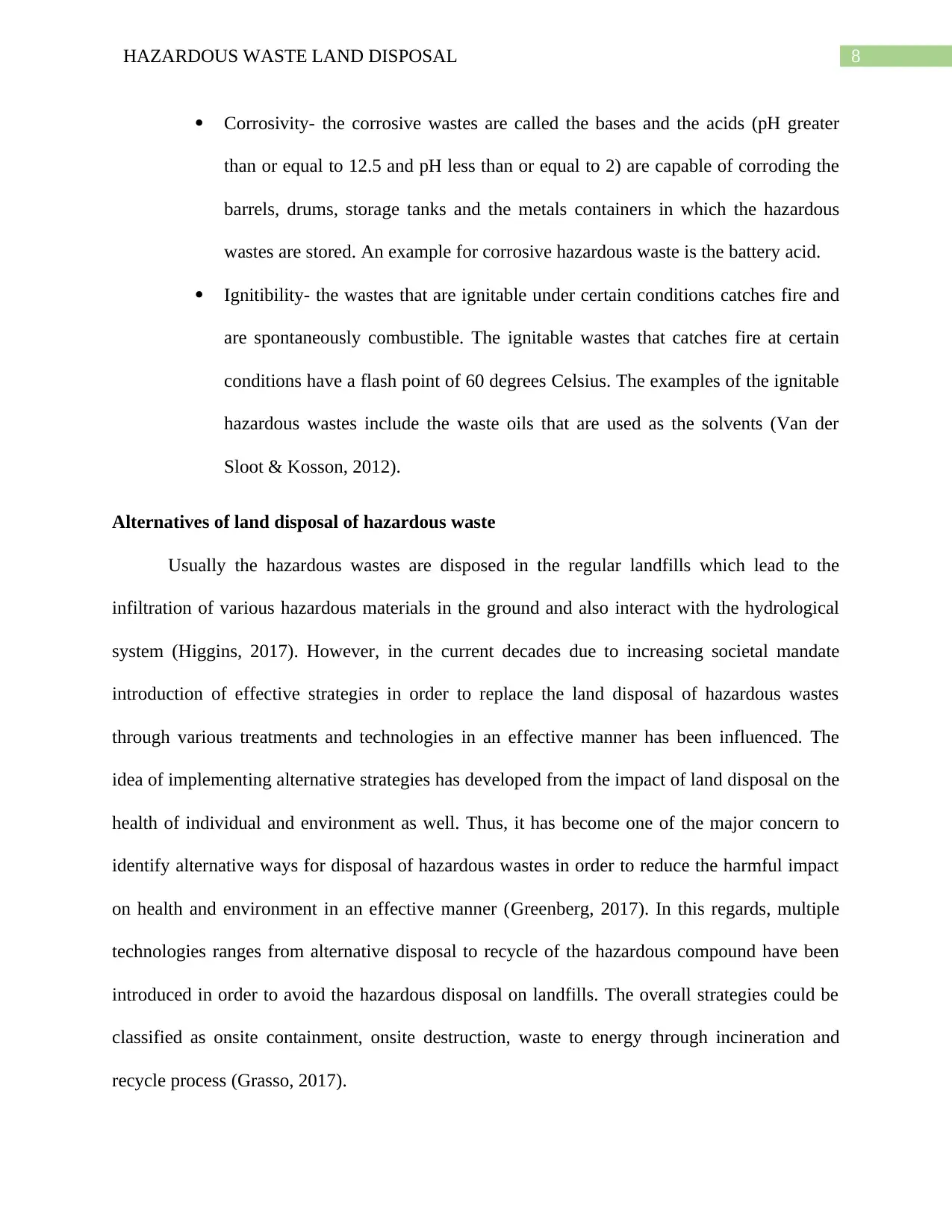
8HAZARDOUS WASTE LAND DISPOSAL
Corrosivity- the corrosive wastes are called the bases and the acids (pH greater
than or equal to 12.5 and pH less than or equal to 2) are capable of corroding the
barrels, drums, storage tanks and the metals containers in which the hazardous
wastes are stored. An example for corrosive hazardous waste is the battery acid.
Ignitibility- the wastes that are ignitable under certain conditions catches fire and
are spontaneously combustible. The ignitable wastes that catches fire at certain
conditions have a flash point of 60 degrees Celsius. The examples of the ignitable
hazardous wastes include the waste oils that are used as the solvents (Van der
Sloot & Kosson, 2012).
Alternatives of land disposal of hazardous waste
Usually the hazardous wastes are disposed in the regular landfills which lead to the
infiltration of various hazardous materials in the ground and also interact with the hydrological
system (Higgins, 2017). However, in the current decades due to increasing societal mandate
introduction of effective strategies in order to replace the land disposal of hazardous wastes
through various treatments and technologies in an effective manner has been influenced. The
idea of implementing alternative strategies has developed from the impact of land disposal on the
health of individual and environment as well. Thus, it has become one of the major concern to
identify alternative ways for disposal of hazardous wastes in order to reduce the harmful impact
on health and environment in an effective manner (Greenberg, 2017). In this regards, multiple
technologies ranges from alternative disposal to recycle of the hazardous compound have been
introduced in order to avoid the hazardous disposal on landfills. The overall strategies could be
classified as onsite containment, onsite destruction, waste to energy through incineration and
recycle process (Grasso, 2017).
Corrosivity- the corrosive wastes are called the bases and the acids (pH greater
than or equal to 12.5 and pH less than or equal to 2) are capable of corroding the
barrels, drums, storage tanks and the metals containers in which the hazardous
wastes are stored. An example for corrosive hazardous waste is the battery acid.
Ignitibility- the wastes that are ignitable under certain conditions catches fire and
are spontaneously combustible. The ignitable wastes that catches fire at certain
conditions have a flash point of 60 degrees Celsius. The examples of the ignitable
hazardous wastes include the waste oils that are used as the solvents (Van der
Sloot & Kosson, 2012).
Alternatives of land disposal of hazardous waste
Usually the hazardous wastes are disposed in the regular landfills which lead to the
infiltration of various hazardous materials in the ground and also interact with the hydrological
system (Higgins, 2017). However, in the current decades due to increasing societal mandate
introduction of effective strategies in order to replace the land disposal of hazardous wastes
through various treatments and technologies in an effective manner has been influenced. The
idea of implementing alternative strategies has developed from the impact of land disposal on the
health of individual and environment as well. Thus, it has become one of the major concern to
identify alternative ways for disposal of hazardous wastes in order to reduce the harmful impact
on health and environment in an effective manner (Greenberg, 2017). In this regards, multiple
technologies ranges from alternative disposal to recycle of the hazardous compound have been
introduced in order to avoid the hazardous disposal on landfills. The overall strategies could be
classified as onsite containment, onsite destruction, waste to energy through incineration and
recycle process (Grasso, 2017).
⊘ This is a preview!⊘
Do you want full access?
Subscribe today to unlock all pages.

Trusted by 1+ million students worldwide
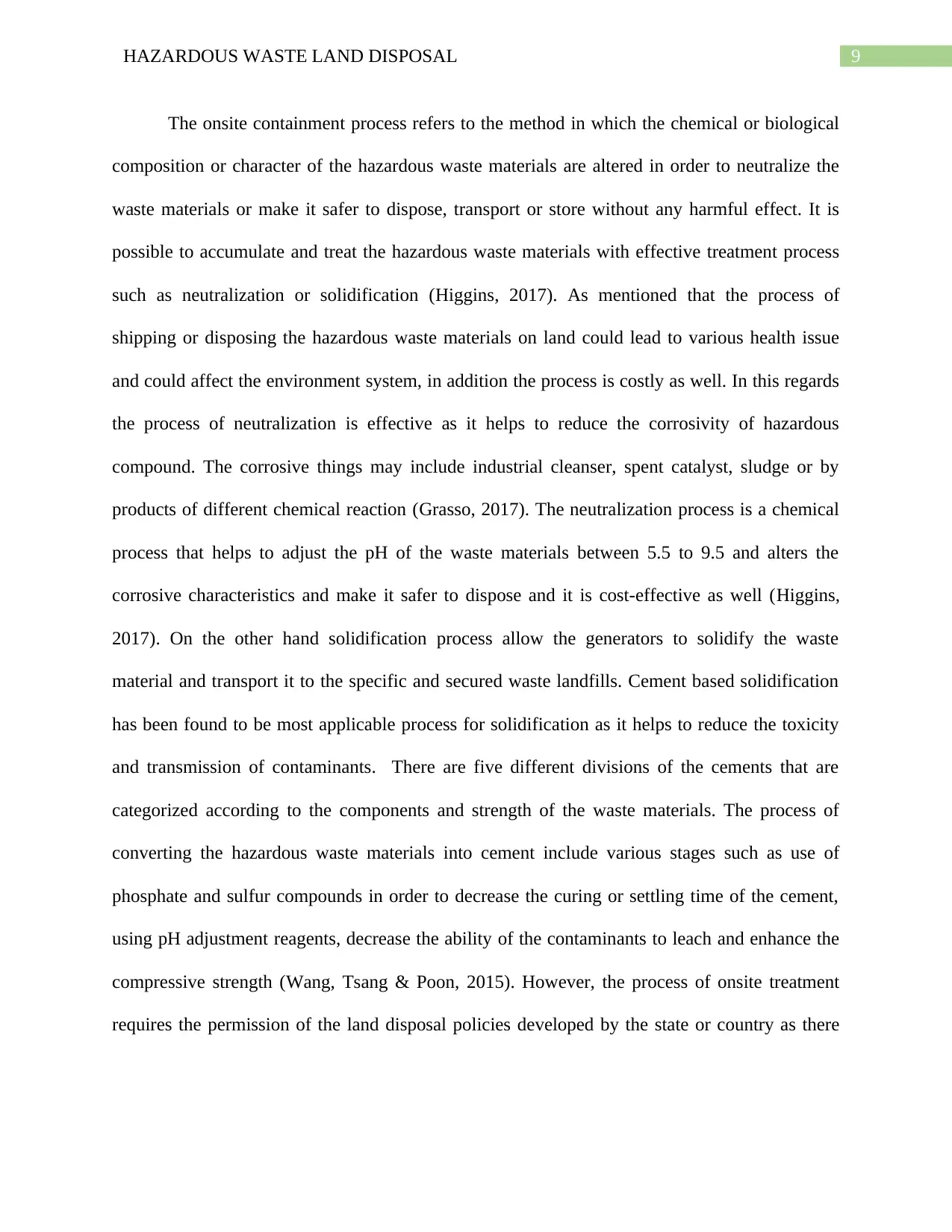
9HAZARDOUS WASTE LAND DISPOSAL
The onsite containment process refers to the method in which the chemical or biological
composition or character of the hazardous waste materials are altered in order to neutralize the
waste materials or make it safer to dispose, transport or store without any harmful effect. It is
possible to accumulate and treat the hazardous waste materials with effective treatment process
such as neutralization or solidification (Higgins, 2017). As mentioned that the process of
shipping or disposing the hazardous waste materials on land could lead to various health issue
and could affect the environment system, in addition the process is costly as well. In this regards
the process of neutralization is effective as it helps to reduce the corrosivity of hazardous
compound. The corrosive things may include industrial cleanser, spent catalyst, sludge or by
products of different chemical reaction (Grasso, 2017). The neutralization process is a chemical
process that helps to adjust the pH of the waste materials between 5.5 to 9.5 and alters the
corrosive characteristics and make it safer to dispose and it is cost-effective as well (Higgins,
2017). On the other hand solidification process allow the generators to solidify the waste
material and transport it to the specific and secured waste landfills. Cement based solidification
has been found to be most applicable process for solidification as it helps to reduce the toxicity
and transmission of contaminants. There are five different divisions of the cements that are
categorized according to the components and strength of the waste materials. The process of
converting the hazardous waste materials into cement include various stages such as use of
phosphate and sulfur compounds in order to decrease the curing or settling time of the cement,
using pH adjustment reagents, decrease the ability of the contaminants to leach and enhance the
compressive strength (Wang, Tsang & Poon, 2015). However, the process of onsite treatment
requires the permission of the land disposal policies developed by the state or country as there
The onsite containment process refers to the method in which the chemical or biological
composition or character of the hazardous waste materials are altered in order to neutralize the
waste materials or make it safer to dispose, transport or store without any harmful effect. It is
possible to accumulate and treat the hazardous waste materials with effective treatment process
such as neutralization or solidification (Higgins, 2017). As mentioned that the process of
shipping or disposing the hazardous waste materials on land could lead to various health issue
and could affect the environment system, in addition the process is costly as well. In this regards
the process of neutralization is effective as it helps to reduce the corrosivity of hazardous
compound. The corrosive things may include industrial cleanser, spent catalyst, sludge or by
products of different chemical reaction (Grasso, 2017). The neutralization process is a chemical
process that helps to adjust the pH of the waste materials between 5.5 to 9.5 and alters the
corrosive characteristics and make it safer to dispose and it is cost-effective as well (Higgins,
2017). On the other hand solidification process allow the generators to solidify the waste
material and transport it to the specific and secured waste landfills. Cement based solidification
has been found to be most applicable process for solidification as it helps to reduce the toxicity
and transmission of contaminants. There are five different divisions of the cements that are
categorized according to the components and strength of the waste materials. The process of
converting the hazardous waste materials into cement include various stages such as use of
phosphate and sulfur compounds in order to decrease the curing or settling time of the cement,
using pH adjustment reagents, decrease the ability of the contaminants to leach and enhance the
compressive strength (Wang, Tsang & Poon, 2015). However, the process of onsite treatment
requires the permission of the land disposal policies developed by the state or country as there
Paraphrase This Document
Need a fresh take? Get an instant paraphrase of this document with our AI Paraphraser
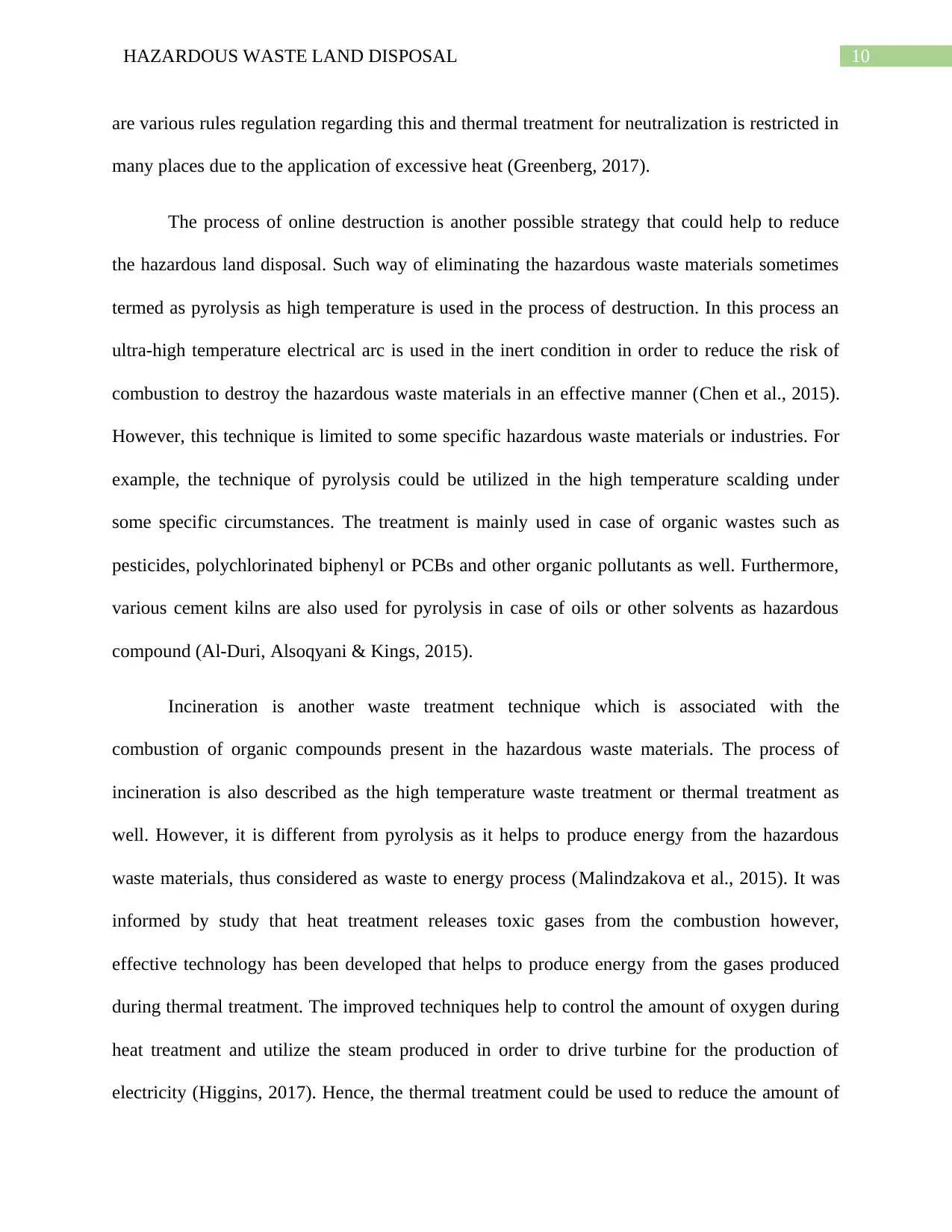
10HAZARDOUS WASTE LAND DISPOSAL
are various rules regulation regarding this and thermal treatment for neutralization is restricted in
many places due to the application of excessive heat (Greenberg, 2017).
The process of online destruction is another possible strategy that could help to reduce
the hazardous land disposal. Such way of eliminating the hazardous waste materials sometimes
termed as pyrolysis as high temperature is used in the process of destruction. In this process an
ultra-high temperature electrical arc is used in the inert condition in order to reduce the risk of
combustion to destroy the hazardous waste materials in an effective manner (Chen et al., 2015).
However, this technique is limited to some specific hazardous waste materials or industries. For
example, the technique of pyrolysis could be utilized in the high temperature scalding under
some specific circumstances. The treatment is mainly used in case of organic wastes such as
pesticides, polychlorinated biphenyl or PCBs and other organic pollutants as well. Furthermore,
various cement kilns are also used for pyrolysis in case of oils or other solvents as hazardous
compound (Al-Duri, Alsoqyani & Kings, 2015).
Incineration is another waste treatment technique which is associated with the
combustion of organic compounds present in the hazardous waste materials. The process of
incineration is also described as the high temperature waste treatment or thermal treatment as
well. However, it is different from pyrolysis as it helps to produce energy from the hazardous
waste materials, thus considered as waste to energy process (Malindzakova et al., 2015). It was
informed by study that heat treatment releases toxic gases from the combustion however,
effective technology has been developed that helps to produce energy from the gases produced
during thermal treatment. The improved techniques help to control the amount of oxygen during
heat treatment and utilize the steam produced in order to drive turbine for the production of
electricity (Higgins, 2017). Hence, the thermal treatment could be used to reduce the amount of
are various rules regulation regarding this and thermal treatment for neutralization is restricted in
many places due to the application of excessive heat (Greenberg, 2017).
The process of online destruction is another possible strategy that could help to reduce
the hazardous land disposal. Such way of eliminating the hazardous waste materials sometimes
termed as pyrolysis as high temperature is used in the process of destruction. In this process an
ultra-high temperature electrical arc is used in the inert condition in order to reduce the risk of
combustion to destroy the hazardous waste materials in an effective manner (Chen et al., 2015).
However, this technique is limited to some specific hazardous waste materials or industries. For
example, the technique of pyrolysis could be utilized in the high temperature scalding under
some specific circumstances. The treatment is mainly used in case of organic wastes such as
pesticides, polychlorinated biphenyl or PCBs and other organic pollutants as well. Furthermore,
various cement kilns are also used for pyrolysis in case of oils or other solvents as hazardous
compound (Al-Duri, Alsoqyani & Kings, 2015).
Incineration is another waste treatment technique which is associated with the
combustion of organic compounds present in the hazardous waste materials. The process of
incineration is also described as the high temperature waste treatment or thermal treatment as
well. However, it is different from pyrolysis as it helps to produce energy from the hazardous
waste materials, thus considered as waste to energy process (Malindzakova et al., 2015). It was
informed by study that heat treatment releases toxic gases from the combustion however,
effective technology has been developed that helps to produce energy from the gases produced
during thermal treatment. The improved techniques help to control the amount of oxygen during
heat treatment and utilize the steam produced in order to drive turbine for the production of
electricity (Higgins, 2017). Hence, the thermal treatment could be used to reduce the amount of
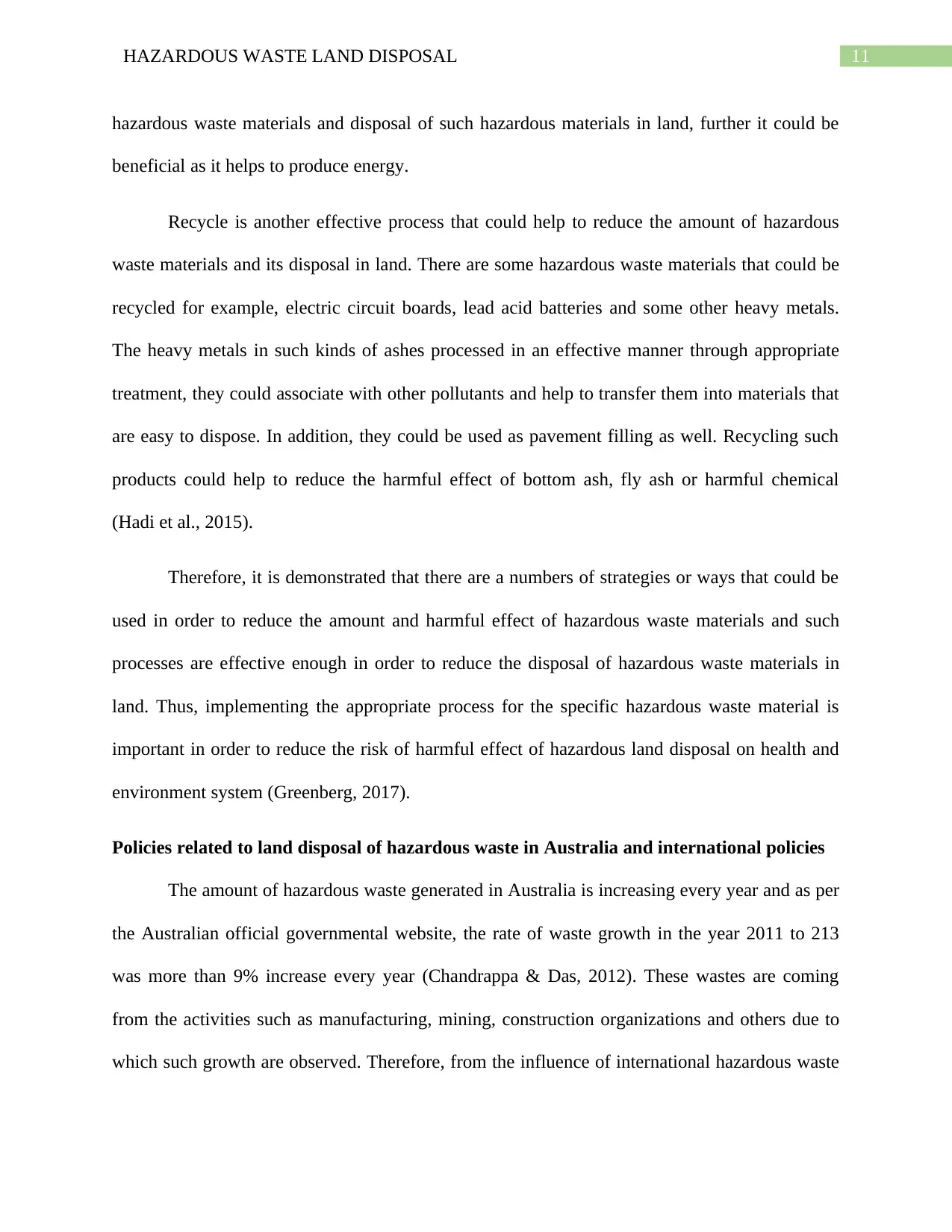
11HAZARDOUS WASTE LAND DISPOSAL
hazardous waste materials and disposal of such hazardous materials in land, further it could be
beneficial as it helps to produce energy.
Recycle is another effective process that could help to reduce the amount of hazardous
waste materials and its disposal in land. There are some hazardous waste materials that could be
recycled for example, electric circuit boards, lead acid batteries and some other heavy metals.
The heavy metals in such kinds of ashes processed in an effective manner through appropriate
treatment, they could associate with other pollutants and help to transfer them into materials that
are easy to dispose. In addition, they could be used as pavement filling as well. Recycling such
products could help to reduce the harmful effect of bottom ash, fly ash or harmful chemical
(Hadi et al., 2015).
Therefore, it is demonstrated that there are a numbers of strategies or ways that could be
used in order to reduce the amount and harmful effect of hazardous waste materials and such
processes are effective enough in order to reduce the disposal of hazardous waste materials in
land. Thus, implementing the appropriate process for the specific hazardous waste material is
important in order to reduce the risk of harmful effect of hazardous land disposal on health and
environment system (Greenberg, 2017).
Policies related to land disposal of hazardous waste in Australia and international policies
The amount of hazardous waste generated in Australia is increasing every year and as per
the Australian official governmental website, the rate of waste growth in the year 2011 to 213
was more than 9% increase every year (Chandrappa & Das, 2012). These wastes are coming
from the activities such as manufacturing, mining, construction organizations and others due to
which such growth are observed. Therefore, from the influence of international hazardous waste
hazardous waste materials and disposal of such hazardous materials in land, further it could be
beneficial as it helps to produce energy.
Recycle is another effective process that could help to reduce the amount of hazardous
waste materials and its disposal in land. There are some hazardous waste materials that could be
recycled for example, electric circuit boards, lead acid batteries and some other heavy metals.
The heavy metals in such kinds of ashes processed in an effective manner through appropriate
treatment, they could associate with other pollutants and help to transfer them into materials that
are easy to dispose. In addition, they could be used as pavement filling as well. Recycling such
products could help to reduce the harmful effect of bottom ash, fly ash or harmful chemical
(Hadi et al., 2015).
Therefore, it is demonstrated that there are a numbers of strategies or ways that could be
used in order to reduce the amount and harmful effect of hazardous waste materials and such
processes are effective enough in order to reduce the disposal of hazardous waste materials in
land. Thus, implementing the appropriate process for the specific hazardous waste material is
important in order to reduce the risk of harmful effect of hazardous land disposal on health and
environment system (Greenberg, 2017).
Policies related to land disposal of hazardous waste in Australia and international policies
The amount of hazardous waste generated in Australia is increasing every year and as per
the Australian official governmental website, the rate of waste growth in the year 2011 to 213
was more than 9% increase every year (Chandrappa & Das, 2012). These wastes are coming
from the activities such as manufacturing, mining, construction organizations and others due to
which such growth are observed. Therefore, from the influence of international hazardous waste
⊘ This is a preview!⊘
Do you want full access?
Subscribe today to unlock all pages.

Trusted by 1+ million students worldwide
1 out of 17
Related Documents
Your All-in-One AI-Powered Toolkit for Academic Success.
+13062052269
info@desklib.com
Available 24*7 on WhatsApp / Email
![[object Object]](/_next/static/media/star-bottom.7253800d.svg)
Unlock your academic potential
Copyright © 2020–2025 A2Z Services. All Rights Reserved. Developed and managed by ZUCOL.





